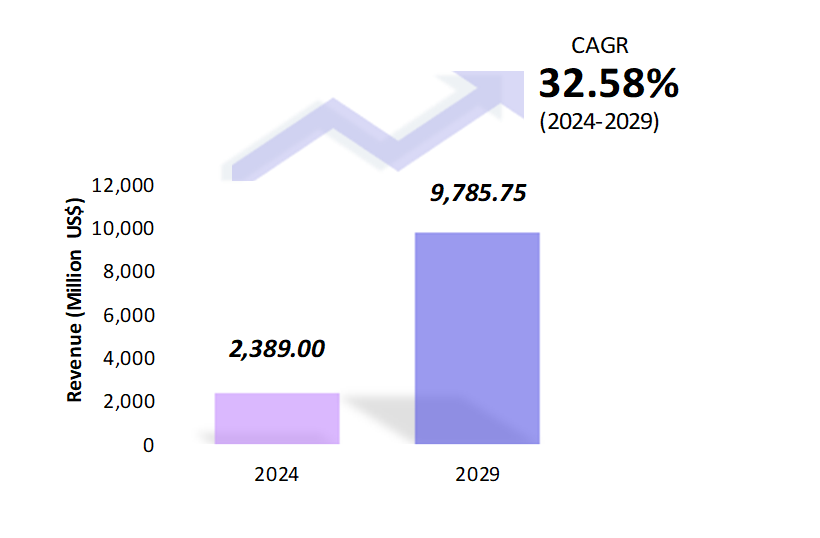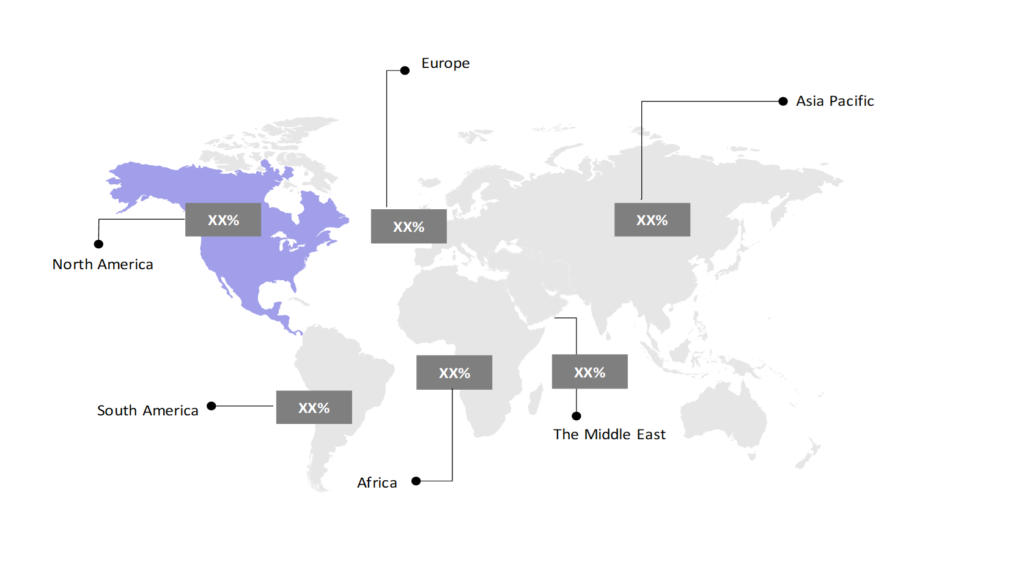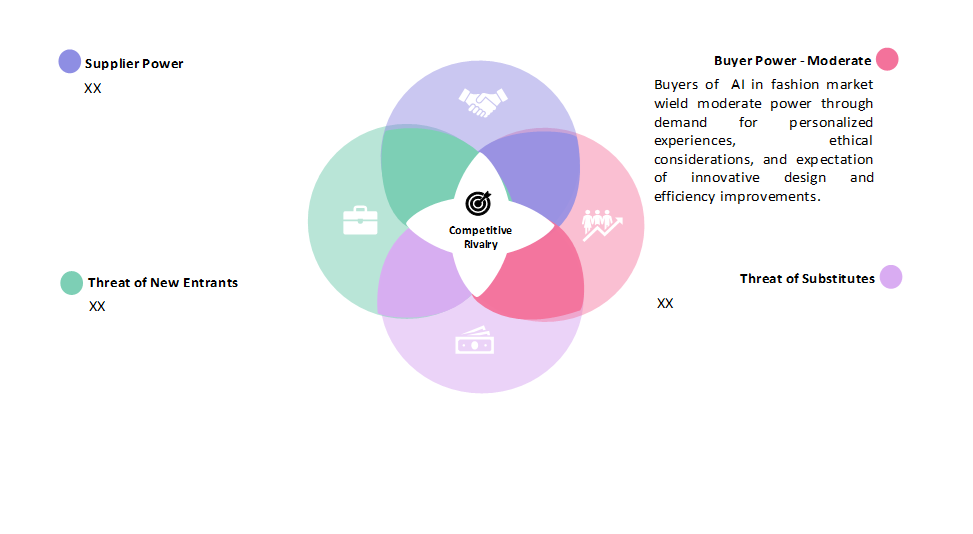AI in Fashion Market: Size, Share, Trends & Forecast (2024-2029)
The report covers a comprehensive analysis segmented by Component (Solution, Software Tools, Platform, Services, Training and Consulting, System Integration and Testing, Support and Maintenance), by Deployment (Product Recommendation, Product Search and Discovery, Supply Chain Management and Demand Forecasting, Creative Designing and Trend Forecasting, Customer Relationship Management, Virtual Assistants), by Type (Apparel, Accessories, Beauty and Cosmetics, Jewelry and Watches), by Application (Cloud, On-Premises), by Geography (North America, South America, Asia Pacific, Europe, the Middle East, Africa).
AI in Fashion Market Snapshot

AI in Fashion Market Overview
The global Artificial Intelligence (AI) in fashion market is estimated to be at $2389 Mn in 2024 and is anticipated to reach $9785.75 Mn in 2029. The global AI in fashion market is registering a CAGR of 32.58% during the forecast period 2024-2029. Artificial Intelligence (AI) in the fashion market is experiencing rapid growth, driven by technological advancements and increasing consumer demand for personalized experiences. AI is revolutionizing various aspects of the fashion industry, from design and manufacturing to marketing and retail. Key players are leveraging AI to enhance operational efficiency, improve customer engagement, and drive innovation.
One significant area of AI’s impact is trend forecasting and consumer insights. AI algorithms analyze vast amounts of data from social media, fashion shows, and online searches to identify emerging trends and consumer preferences in real time. This enables fashion brands to adapt quickly to changing market demands and produce collections that resonate with their target audience.
In design and product development, AI tools are being used to generate and optimize designs, speeding up the creative process and reducing time-to-market. For example, AI-powered pattern recognition and design software can assist designers in creating unique and intricate patterns more efficiently than traditional methods.
In manufacturing, AI is enhancing production efficiency through predictive maintenance, supply chain optimization, and automation. AI-driven predictive analytics help manufacturers anticipate demand fluctuations and optimize inventory management, reducing waste and operational costs.
Customer engagement is another area where AI is making a significant impact. Virtual fitting rooms powered by AI allow customers to visualize how clothing will look on them before making a purchase, enhancing the online shopping experience. AI-powered chatbots and virtual assistants provide personalized recommendations and customer support, improving satisfaction and retention rates. Despite these advancements, challenges such as data privacy concerns, algorithmic bias, and the ethical implications of AI in fashion remain. As the market continues to evolve, stakeholders must address these challenges to ensure the responsible and sustainable integration of AI technologies in the fashion industry. Overall, AI holds immense potential to drive innovation and efficiency in fashion, promising a future where creativity and technology converge to redefine the industry landscape.
AI in Fashion Market Coverage
| Historical & Forecast Period | 2018-2029 |
| Base Year | 2023 |
| Forecast Period | 2024-2029 |
| Units | Billion US$ |
| Segments | Component, Deployment, Type, Application |
| Geographies | North America, South America, Asia Pacific, Europe, The Middle East, Africa |
| Key Vendors | Microsoft Corp., International Business Machines Corp., Alphabet Inc., Amazon.com, Inc., SAP AG |
Key Geographies of AI in Fashion Market, 2023

Porter’s 5 Forces Analysis of AI in Fashion Market

AI in Fashion Market Trends
Recent trends in artificial intelligence in the fashion market highlight significant advancements and integrations aimed at enhancing the shopping experience and operational efficiency. One notable trend is the increasing use of AI for personalized fashion recommendations. Platforms like Amazon Fashion and True Fit leverage AI to analyze vast amounts of customer data, providing tailored size and style suggestions to improve fit accuracy and reduce returns.
Another trend is the rise of virtual try-on solutions. Companies like AR-powered Zeekit, acquired by Walmart, enable customers to see how clothes look on their bodies without physically trying them on. This technology uses AI to create realistic, interactive fitting experiences, helping customers make better purchasing decisions.
AI is also being utilized for inventory management and demand forecasting. Brands like H&M and Zara use AI to predict fashion trends and manage stock levels more efficiently. By analyzing data from various sources, these AI systems help retailers optimize their supply chains and reduce overproduction.
Moreover, AI is enhancing customer service through chatbots and virtual assistants. For instance, The Shirt Dandy’s collaboration with Tailor aims to use AI as a personal shopping advisor, providing customized recommendations based on customer preferences and queries. This trend is expanding across the fashion industry, with many retailers adopting AI-powered chatbots to assist with customer inquiries and streamline the shopping process. In summary, sustainability is becoming a key focus, with AI helping brands make eco-friendly decisions. Companies are using AI to analyze the environmental impact of their materials and production processes, striving to create more sustainable fashion lines.
AI in Fashion Market Driving Factors
The growth of AI in the fashion market is driven by several key factors. The increasing demand for personalized shopping experiences propels the adoption of AI technologies. Consumers today expect tailored recommendations, which AI delivers by analyzing individual preferences and purchase histories. This enhances customer satisfaction and boosts sales, with fashion market statistics showing significant improvements in conversion rates due to AI integration.
The efficiency and accuracy of inventory management systems powered by AI drive market growth. AI algorithms predict trends and optimize stock levels, reducing overproduction and minimizing waste. This leads to cost savings for retailers and aligns with sustainable fashion practices, which are increasingly important to consumers and regulatory bodies.
The adoption of AI in fashion is also spurred by its ability to enhance the design and production processes. AI tools can forecast trends, analyze consumer sentiment, and even assist in the creation of new designs, enabling faster and more efficient product development. This innovation shortens the time-to-market for new collections, giving brands a competitive edge.
Furthermore, AI’s role in improving supply chain logistics is a significant driver. AI solutions streamline operations from manufacturing to delivery, ensuring timely restocking and reducing shipping delays. This operational efficiency translates into better customer experiences and higher profit margins.
The increasing investment in AI technologies by major fashion retailers and tech companies fuel market growth. As these entities develop more advanced AI applications, smaller brands and retailers also gain access to these innovations, democratizing AI’s benefits across the industry. For instance, Shopify’s partnership with True Fit aims to provide smaller online fashion retailers with access to advanced AI-driven fit solutions. Shopify, a leading e-commerce platform, integrates True Fit’s data-driven AI capabilities to offer personalized sizing and fit recommendations. This partnership not only enhances the shopping experience for customers but also allows small retailers to leverage sophisticated AI technology without needing to invest heavily in their own AI development. This democratization of AI benefits showcases how investments by major companies can trickle down to empower smaller players in the fashion market.
In summary, the fashion industry is driven by artificial intelligence (AI) due to various factors such as the need for customization, improved inventory control, expedited design processes, streamlined supply chains, and substantial investments in AI technology.
AI in Fashion Market Challenges
The AI in Fashion market faces several challenges amidst its burgeoning growth. One major hurdle is the integration of AI technologies into traditional design processes. While AI can streamline tasks like trend analysis and customer segmentation, its ability to truly innovate in creative design remains a debated point. Fashion, often driven by human creativity and emotion, poses a unique challenge for AI, which typically excels in data-driven decision-making rather than artistic intuition.
Moreover, ethical concerns surrounding AI’s role in fashion are gaining prominence. Issues such as data privacy, algorithmic bias in customer targeting, and the environmental impact of AI-driven production processes are increasingly scrutinized. For instance, AI-powered personalization can inadvertently reinforce stereotypes or exclude certain demographics if not carefully monitored.
Businesses such as Stitch Fix leverage artificial intelligence (AI) algorithms to customize apparel suggestions according to client choices, showcasing AI’s capacity to improve the customer journey. Conversely, controversies arise when AI-driven design tools generate designs resembling existing copyrighted works, raising legal and ethical questions about intellectual property rights and originality in AI-generated content. In conclusion, while AI offers significant opportunities for efficiency and personalization in the fashion industry, its adoption must navigate substantial challenges. Balancing technological innovation with ethical considerations and preserving human creativity remains pivotal for the sustainable integration of AI in fashion.
AI in Fashion Market – Key Industry News
- In April 2024, The Shirt Dandy, a Viennese start-up specializing in custom shirts for men in India, strengthened its strategic partnership with Tailor, the software division of Italian wool mill Successor Reda S.p.A. This collaboration aims to introduce advanced AI capabilities to the Indian market, leveraging Tailor’s AI-driven digital platform to enhance The Shirt Dandy’s offerings.
- In January 2024, Amazon Fashion is leveraging AI to revolutionize the online shopping experience with features like personalized size recommendations, Fit Review Highlights, reimagined size charts, and the Fit Insights Tool. These innovations use deep learning algorithms and natural language processing to analyze vast amounts of data, including customer reviews and purchase histories, to offer precise sizing advice and highlight key fit details. By continuously adapting to changes in customer sizing needs and providing brands with data-driven insights, Amazon aims to reduce return rates and improve customer satisfaction, making online fashion shopping more personalized and efficient
- In August 2023, True Fit, a data-driven AI platform, partnered with Shopify to assist small digital fashion retailers in addressing fit-related issues. This collaboration aims to leverage True Fit’s advanced AI capabilities to provide personalized sizing and fit recommendations, enhancing the shopping experience for customers. By integrating with Shopify, True Fit’s technology will be accessible to smaller online fashion retailers, helping them reduce returns and increase customer satisfaction. This initiative marks a significant step in democratizing AI-driven fit solutions, allowing small businesses to compete more effectively in the digital fashion market.
AI in Fashion Market Competitive Landscape
The competitive landscape of AI in the fashion market is characterized by a blend of technological innovation and strategic partnerships between technology firms and fashion brands. Companies like Stitch Fix have leveraged AI algorithms to personalize clothing recommendations based on extensive customer data, thereby enhancing the overall shopping experience. This approach not only improves customer satisfaction but also boosts sales by aligning product offerings with individual preferences in real time.
Amazon has made significant strides in the AI fashion retail sector by deploying sophisticated product recommendation systems and virtual try-on features. These technologies not only engage customers more effectively but also reduce the uncertainty associated with online shopping, thereby increasing conversion rates. Similarly, IBM Watson has positioned itself as a leader in providing AI solutions tailored for fashion retailers. Their offerings range from optimizing supply chains and predicting consumer trends to enhancing operational efficiency through advanced analytics. Vue.ai (formerly Mad Street Den) exemplifies the integration of AI in visual merchandising, offering solutions that enable brands to create personalized shopping experiences through visual search and styling recommendations. This capability not only drives customer engagement but also strengthens brand loyalty by delivering tailored experiences that resonate with individual preferences. Overall, the competitive dynamics in the AI fashion market underscore the importance of innovation and strategic collaboration. Companies that can effectively harness AI to deliver personalized, efficient, and engaging experiences are likely to gain a competitive edge in an industry increasingly shaped by technological advancements and evolving consumer expectations.
AI in Fashion Market Company Share Analysis, 2023 (%)

AI in Fashion Market – Key Companies

Reason to Buy from us

Table of Contents
| 1. Introduction |
|---|
| 1.1. Research Methodology |
| 1.2. Scope of the Study |
| 2. Market Overview / Executive Summary |
| 2.1. Global AI in Fashion Market (2018 – 2022) |
| 2.2. Global AI in Fashion Market (2023 – 2029) |
| 3. Market Segmentation |
| 3.1. Global AI in Fashion Market by Component |
| 3.1.1. Solution |
| 3.1.2. Software Tools |
| 3.1.3. Platform |
| 3.1.4. Services |
| 3.1.5. Training and Consulting |
| 3.1.6. System Integration and Testing |
| 3.1.7. Support and Maintenance |
| 3.2. Global AI in Fashion Market by Deployment |
| 3.2.1. Product Recommendation |
| 3.2.2. Product Search and Discovery |
| 3.2.3. Supply Chain Management and Demand Forecasting |
| 3.2.4. Creative Designing and Trend Forecasting |
| 3.2.5. Customer Relationship Management |
| 3.2.6. Virtual Assistants |
| 3.3. Global AI in Fashion Market by Type |
| 3.3.1. Apparel |
| 3.3.2. Accessories |
| 3.3.3. Beauty and Cosmetics |
| 3.3.4. Jewelry and Watches |
| 3.4. Global AI in Fashion Market by Application |
| 3.4.1. Cloud |
| 3.4.2. On- Premises |
| 4. Regional Segmentation |
| 4.1. North America |
| 4.1.1. The U.S |
| 4.1.2. Canada |
| 4.1.3. Mexico |
| 4.2. South America |
| 4.2.1. Brazil |
| 4.2.2. Argentina |
| 4.2.3. Colombia |
| 4.2.4. Chile |
| 4.2.5. Rest of South America |
| 4.3. Asia Pacific |
| 4.3.1. China |
| 4.3.2. India |
| 4.3.3. Japan |
| 4.3.4. South Korea |
| 4.3.5. Rest of Asia Pacific |
| 4.4. Europe |
| 4.4.1. UK |
| 4.4.2. Germany |
| 4.4.3. Italy |
| 4.4.4. France |
| 4.4.5. Spain |
| 4.4.6. Rest of Europe |
| 4.5. The Middle East |
| 4.5.1. Turkey |
| 4.5.2. UAE |
| 4.5.3. Saudi Arabia |
| 4.5.4. Rest of the Middle East |
| 4.6. Africa |
| 4.6.1. Egypt |
| 4.6.2. South Africa |
| 4.6.3. Rest of Africa |
| 5. Value Chain Analysis of the Global AI in Fashion Market |
| 6. Porter Five Forces Analysis |
| 6.1. Threats of New Entrants |
| 6.2. Threats of Substitutes |
| 6.3. Bargaining Power of Buyers |
| 6.4. Bargaining Power of Suppliers |
| 6.5. Competition in the Industry |
| 7. Trends, Drivers and Challenges Analysis |
| 7.1. Market Trends |
| 7.1.1. Market Trend 1 |
| 7.1.2. Market Trend 2 |
| 7.1.3. Market Trend 3 |
| 7.2. Market Drivers |
| 7.2.1. Market Driver 1 |
| 7.2.2. Market Driver 2 |
| 7.2.3. Market Driver 3 |
| 7.3. Market Challenges |
| 7.3.1. Market Challenge 1 |
| 7.3.2. Market Challenge 2 |
| 7.3.3. Market Challenge 3 |
| 8. Competitive Landscape |
| 8.1. Microsoft Corp. |
| 8.2. International Business Machines Corp. |
| 8.3. Alphabet Inc. |
| 8.4. Amazon.com, Inc. |
| 8.5. SAP AG |
| 8.6. Company 6 |
| 8.7. Company 7 |
| 8.8. Company 8 |
| 8.9. Company 9 |
| 8.10. Company 10 |
AI in Fashion Market – Frequently Asked Questions (FAQs)
What is the current size of the global AI in fashion market?
The market size for the global AI in fashion market in 2024 is $2389 Mn.
Who are the major vendors in the global AI fashion market?
The major vendors in the global AI in fashion market are Microsoft Corp., International Business Machines Corp., Alphabet Inc., Amazon.com, Inc., and SAP AG.
Which segments are covered under the global AI in fashion market segments analysis?
This report offers in-depth insights into each component, deployment, type, and application.
